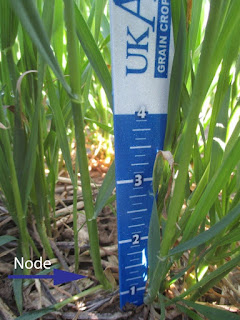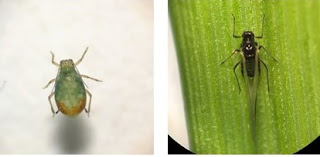Carrie Knott, Extension Agronomist-Princeton, University of Kentucky
Lloyd Murdock, Emeritus Extension Soil Specialist, University of Kentucky
Edwin Ritchey, Extension Soil Specialist-Princeton, University of Kentucky
 |
| Table 1. Wheat plants at jointing (Feekes 6). |
Unseasonably warm temperatures in KY since wheat planting (October 15, 2016) may become a major challenge to wheat yield and profitability this year. Since Oct 15, 2016, KY has accumulated about 2000 GDD growing degree days (GDD) or heat units. In most years, only about 1500 GDD are accumulated by mid-February, while 2000 GDD are typically accumulated around the end of March in KY.
These extraordinarily warm days and large number of GDD have resulted in wheat crops that are at a more advanced growth stage for this time of year. Typically, most of KY wheat in mid-February is beginning to break dormancy and initiate active growth: Feekes 3, Green-up. However, there are several reports in KY that wheat is jointing (Feekes 6; Figures 1 & 2).
This is very concerning because at jointing (Feekes 6) the growing point (developing wheat head) is above the soil surface and is vulnerable to damage, including freeze damage. The risk of freeze damage is quite high because throughout KY there is still at least a 6 to 9 week window that a freeze typically occurs (Table 1).
 |
| Figure 2. Wheat plant at jointing with dissected wheat head. |
Table 1. Probabilities for the date
of the last spring freeze (32°F) in Kentucky based upon data from 1981 to 2010
(Arguez et al., 2010 provided by S. Foster, State Climatologist for Kentucky).
Probabilities that the last spring freeze will occur on or after the date
listed. For example, for 90% probability the last spring freeze will occur on
or later than the date listed 90% of the time (nine out of ten years), while at
the 10% probability level the last spring freeze will occur on or later than
the dates listed 10% of the time (one out of ten years).
|
Kentucky Location
|
Date of Last Spring Freeze (32°F or less) in Kentucky by
Probability Level
|
|
90%
|
50%
|
10%
|
|
Ashland
|
6-Apr
|
24-Apr
|
10-May
|
|
Bardstown
|
30-Mar
|
14-Apr
|
29-Apr
|
|
Bowling
Green
|
25-Mar
|
9-Apr
|
25-Apr
|
|
Covington
|
2-Apr
|
16-Apr
|
2-May
|
|
Danville
|
27-Mar
|
11-Apr
|
27-Apr
|
|
Glasgow
|
29-Mar
|
13-Apr
|
27-Apr
|
|
Henderson
|
24-Mar
|
8-Apr
|
23-Apr
|
|
Hopkinsville
|
24-Mar
|
10-Apr
|
24-Apr
|
|
Leitchfield
|
14-Apr
|
28-Apr
|
15-May
|
|
Lexington
|
29-Mar
|
14-Apr
|
29-Apr
|
|
Mayfield
|
23-Mar
|
9-Apr
|
23-Apr
|
|
Monticello
|
3-Apr
|
20-Apr
|
5-May
|
|
Murray
|
17-Mar
|
2-Apr
|
18-Apr
|
|
Nolan
River Lake
|
3-Apr
|
20-Apr
|
7-May
|
|
Princeton
|
29-Mar
|
13-Apr
|
29-Apr
|
|
Russellville
|
25-Mar
|
11-Apr
|
29-Apr
|
|
Shelbyville
|
16-Apr
|
29-Apr
|
14-May
|
|
Somerset
|
3-Apr
|
20-Apr
|
6-May
|
Considerations:
• For wheat crops that have not received any nitrogen, consider a single nitrogen application as late as Feekes 6 or 7 growth stage. Delaying nitrogen application may reduce plant growth and the risk of freeze damage.
o Research in KY has shown that with sufficient tillers, nitrogen application can be delayed as late
as Feekes 6 or 7 with little or no yield reduction.
o Normally nitrogen is applied by Feekes 5 or 6 to maximize yield. With the accelerated growth
this year, delaying nitrogen application until Feekes 6 or 7 could retard wheat development and
provide additional freeze protection, depending on when a freeze occurs.
o Yield will be reduced if nitrogen application is delayed beyond Feekes 7, such as delays due to
weather or field conditions.
• For wheat crops at jointing, Feekes 6, that have already received nitrogen applications, there is nothing that will protect the crop from freeze damage. The best approach is to consider delaying the second nitrogen application until Feekes 6 or 7, potentially reducing the severity of freeze damage.
• Freeze injury occurs when temperatures fall to 24°F or below for 2 or more hours at the jointing growth stage: Feekes 6.
• If freezing temperatures remain above 24°F there is only a slight risk of freeze damage.
• In Western KY, the wheat crop does not appear to be as advanced as other areas of the state. Last fall there was a considerable drought that may have resulted in ‘dormant’ wheat in the fall (due to lack of water) when other areas of the state wheat was actively growing. These areas will likely be most profitable following ‘normal’ wheat management recommendations.
• Be prepared to scout fields much earlier than usual for insects and plant diseases. The warm winter temperatures have also resulted in greater insect populations in KY, specifically cereal aphid species, which may increase the incidence of barley yellow dwarf virus.




